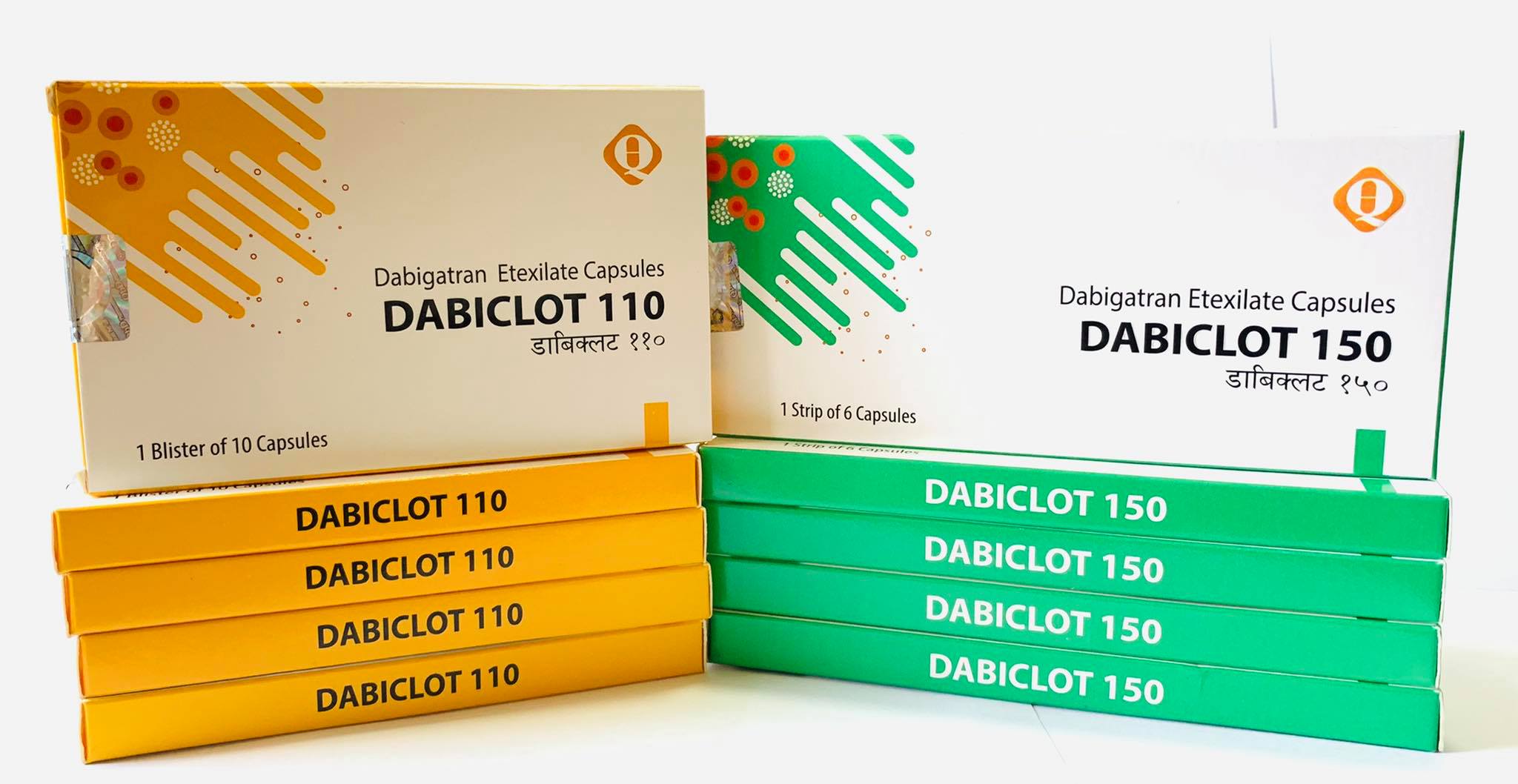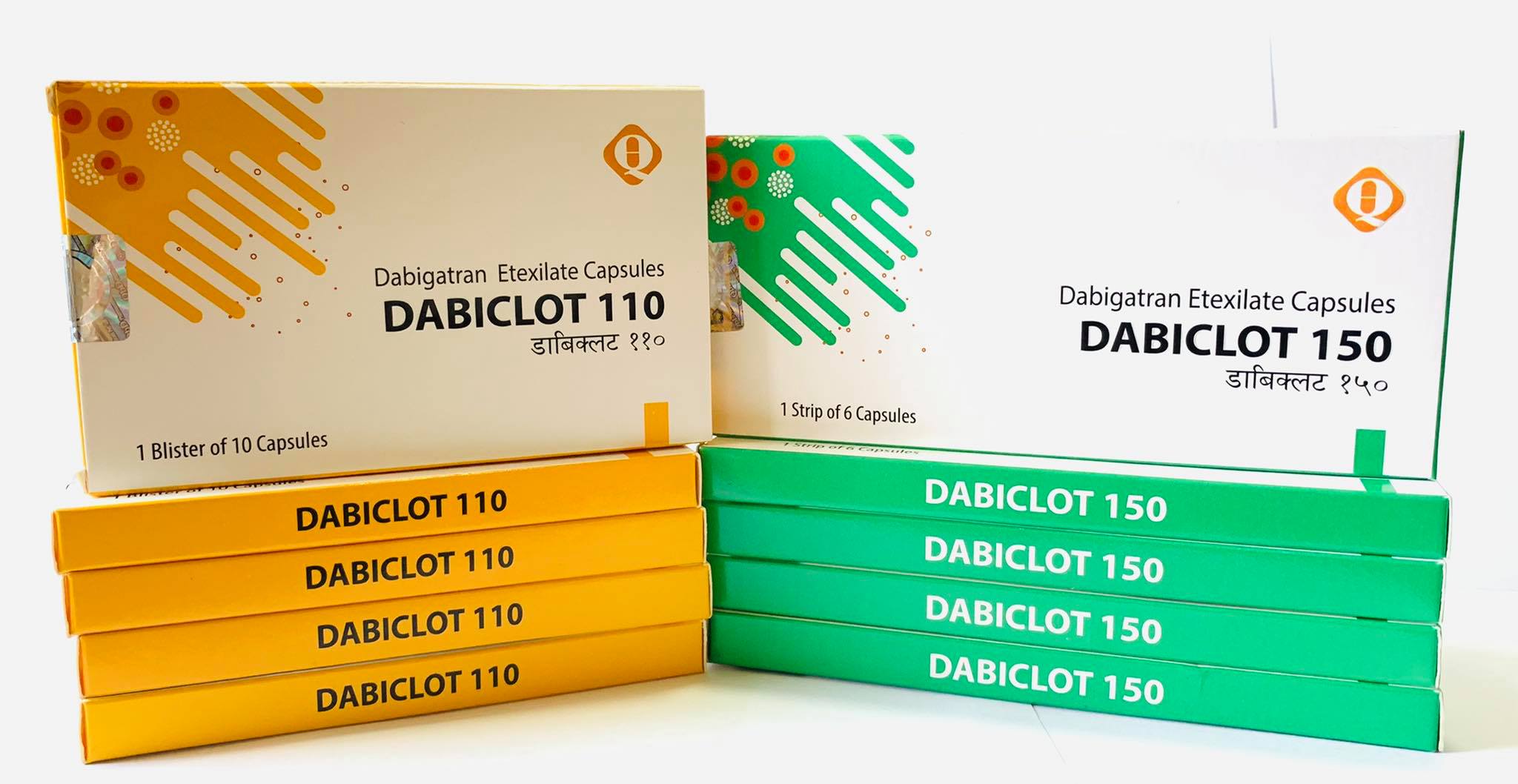Pharmacodynamic properties:-
Pharmacotherapeutic group:
Antithrombotic agents, direct thrombin inhibitors.
Mechanism of Action:-
Dabigatran is a potent, competitive, reversible direct thrombin inhibitor and is the main active principle in plasma. Since thrombin (serine protease) enables the conversion of fibrinogen into fibrin during the coagulation cascade, its inhibition prevents the development of thrombus. Dabigatran inhibits free thrombin, fibrin-bound thrombin and thrombin-induced platelet aggregation.
Pharmacokinetic Properties:-
After oral administration, Dabigatran etexilate is rapidly and completely converted to Dabigatran, which is the active form in plasma. The cleavage of the prodrug Dabigatran etexilate by esterase-catalyzed hydrolysis to the active principle Dabigatran is the predominant metabolic reaction. The absolute bioavailability of Dabigatran following oral administration of Dabigatran was approximately 6.5 %after oral administration of Dabigatran in healthy volunteers, the pharmacokinetic profile of Dabigatran in plasma is characterized by a rapid increase in plasma concentrations with Cmax attained within 0.5 and 2.0 hours post administration.
- Absorption
A study evaluating post-operative absorption of Dabigatran etexilate, 1-3 hours following surgery, demonstrated relatively slow absorption compared with that in healthy volunteers, showing a smooth plasma concentration-time profile without high peak plasma concentrations. Peak plasma concentrations are reached at 6 hours following administration in a postoperative period due to contributing factors such as anesthesia, GI paresis, and surgical effects independent of the oral medicinal product formulation. It was demonstrated in a further study that slow and delayed absorption is usually only present on the day of surgery. On subsequent days absorption of Dabigatran is rapid with peak plasma concentrations attained 2 hours after medicinal product administration. Food does not affect the bioavailability of Dabigatran etexilate but delays the time to peak plasma concentrations by 2 hours. Cmax and AUC were dose proportional. The oral bioavailability may be increased by 75 % after a single dose and 37 % at steady state compared to the reference capsule formulation when the pellets are taken without the Hydroxypropyl methylcellulose (HPMC) capsule shell.
- Distribution
Low (34-35 %) concentration independent binding of Dabigatran to human plasma proteins was observed. The volume of distribution of Dabigatran of 60-70 L exceeded the volume of total body water indicating moderate tissue distribution of Dabigatran.
- Biotransformation:
After oral administration, Dabigatran etexilate is rapidly and completely converted to Dabigatran, which is the active form in plasma. The cleavage of the prodrug Dabigatran etexilate by esterase catalyzed hydrolysis to the active principle Dabigatran is the predominant metabolic reaction. Dabigatran is subject to conjugation forming pharmacologically active acyl glucuronides. Four positional isomers, 1-O, 2-O, 3-O, 4-O-acylglucuronide exist, each accounts for less than 10% of total Dabigatran in plasma. Traces of other metabolites were only detectable with highly sensitive analytical methods.
- Elimination:
Plasma concentrations of Dabigatran showed a bi exponential decline with a mean terminal half-life of 11 hours in healthy elderly subjects. After multiple doses a terminal half-life of about 12-14 hours was observed. The half-life was independent of dose. Half-life is prolonged if renal function is impaired.
Primary prevention of Venous Thromboembolism in orthopedic Surgery
| Clinical Conditions |
Dose recommendation |
| Prevention of stroke and systemic embolism in adult patients with NVAF with one or more risk factors (SPAF) |
Prevention of stroke and systemic embolism in adult patients with NVAF with one or more risk factors (SPAF) 300 mg DABICLOT taken as one 150 mg capsule twice daily |
| Treatment of deep vein thrombosis (DVT) and pulmonary embolism (PE), and prevention of recurrent DVT, and PE in adults (DVT/PE) |
300 mg t DABICLOT taken as one 150 mg capsule twice daily following treatment with a parenteral anticoagulant for at least 5 days |
| Dose reduction recommended |
| Patients aged ≥80 years |
daily dose of 220 mg DABICLOT taken as one 110 mg capsule twice daily |
| Patients who receive concomitant verapamil |
- |
| Dose reduction for consideration |
| Patients between 75-80 years |
- |
| Patients with moderate renal impairment (CrCL 30-50 mL/min) |
Daily dose of DABICLOT of 300 mg or 220 mg should be selected based on an individual assessment of the thromboembolic risk and the risk of bleeding. |
| Patients with gastritis, esophagitis or gastro esophageal reflux |
- |
| Other patients at increased risk of bleeding |
- |
Duration of Use
The duration of use of DABICLOT in the indications SPAF, DVT and PE are shown in table
| Indication Duration of Use |
| SPAF |
Therapy should be continued long term. |
| DVT/PE |
The duration of therapy should be individualized after careful assessment of the treatment benefit against the risk for bleeding. Short duration of therapy (at least 3 months) should be based on transient risk factors (e.g. recent surgery, trauma, and immobilization) and longer durations should be based on permanent risk factors or idiopathic DVT or PE. |
DABICLOT is for oral use. The capsules can be taken with or without food. DABICLOT should be swallowed as a whole with a glass of water, to facilitate delivery to the stomach.
They are ranked under headings of System Organ Class (SOC) and frequency using the following convention: very common (≥ 1/10), common (≥ 1/100 to < 1/10), uncommon (≥ 1/1,000 to < 1/100), rare (≥ 1/10,000 to < 1/1,000), very rare (< 1/10,000), not known (cannot be estimated from the available data).
| |
Frequency |
|
| SOC / Preferred term |
Stroke and systemic embolism prevention in patients witd atrial fibrillation |
DVT/PE treatment and DVT/PE prevention |
| Blood and lymphatic system disorders |
| Anemia |
Common |
- |
| Hemoglobin decreased |
Uncommon |
Not Known |
| Thrombocytopenia |
Uncommon |
Rare |
| Hematocrit decreased |
Rare |
Not Known |
| Immune system disorder |
| Drug hypersensitivity |
Uncommon |
Uncommon |
| Rash |
Uncommon |
Uncommon |
| Pruritus |
Uncommon |
Uncommon |
| Anaphylactic reaction |
Rare |
Rare |
| Urticaria |
Rare |
Rare |
| Angioedema |
Rare |
Rare |
| Bronchospasm |
Not known |
Not known |
| Nervous system disorders |
| Intracranial hemorrhage |
Uncommon |
Rare |
| Vascular disorders |
| Hematoma |
Uncommon |
Common |
| Respiratory, thoracic and mediastinal disorders Epistaxis |
Common |
Common |
| Hemoptysis |
Uncommon |
Uncommon |
| Gastrointestinal disorders |
| Gastrointestinal hemorrhage |
Common |
Common |
| Abdominal pain |
Common |
Uncommon |
| Diarrhea |
Common |
Uncommon |
| Dyspepsia |
Common |
Common |
| Nausea |
Common |
Uncommon |
| Rectal hemorrhage |
Uncommon |
Common |
| Rectal hemorrhage |
Uncommon |
Common |
| Haemorrhoidal hemorrhage |
Uncommon |
Uncommon |
| Gastrointestinal ulcer |
Uncommon |
Uncommon |
| Gastro esophagitis |
Uncommon |
Uncommon |
| Vomiting |
Uncommon |
Uncommon |
| Dysphagia |
Uncommon |
Uncommon |
| Gastro esophageal reflux disease |
Uncommon |
Rare |
| Hepatobiliary disorders |
| Hepatic function abnormal/ Liver function Test abnormal |
Uncommon |
Uncommon |
| Alanine aminotransferase increased |
Uncommon |
Uncommon |
| aspartate aminotransferase increased |
Uncommon |
Uncommon |
| Hepatic enzyme increased |
Rare |
Uncommon |
| Hyperbilirubinaemia |
Rare |
Not Known |
| Skin and subcutaneous tissue disorder |
| Skin hemorrhage |
Common |
Common |
| Musculoskeletal and connective tissue disorders |
| Haemarthrosis |
Rare |
Uncommon |
| Renal and urinary disorders |
| Genitourological hemorrhage, including hematuria |
Common |
Common |
| General disorders and administration site conditions |
| Injection site hemorrhage |
Rare |
Rare |
| Catheter site hemorrhage |
Rare |
Rare |
| Injury, poisoning and procedural complications |
| Traumatic hemorrhage |
Rare |
Uncommon |
| Incision site hemorrhage |
Rare |
Rare |



